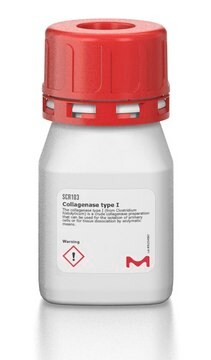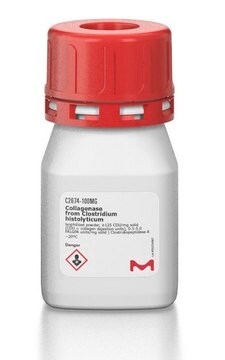C1639
Colagenasa from Clostridium histolyticum
0.2 μm filtered, for general use, Type I-S, 0.2-1.0 FALGPA units/mg solid, ≥125 CDU/mg solid
Sinónimos:
Clostridiopeptidasa A
About This Item
Productos recomendados
Nivel de calidad
esterilidad
0.2 μm filtered
Formulario
lyophilized powder
actividad específica
≥125 CDU/mg solid
0.2-1.0 FALGPA units/mg solid
mol peso
68-130 kDa
temp. de almacenamiento
−20°C
¿Está buscando productos similares? Visita Guía de comparación de productos
Categorías relacionadas
Aplicación
Acciones bioquímicas o fisiológicas
Precaución
Definición de unidad
Nota de preparación
sustrato
Palabra de señalización
Danger
Frases de peligro
Consejos de prudencia
Clasificaciones de peligro
Eye Irrit. 2 - Resp. Sens. 1 - Skin Irrit. 2 - STOT SE 3
Órganos de actuación
Respiratory system
Código de clase de almacenamiento
11 - Combustible Solids
Clase de riesgo para el agua (WGK)
WGK 1
Punto de inflamabilidad (°F)
Not applicable
Punto de inflamabilidad (°C)
Not applicable
Equipo de protección personal
dust mask type N95 (US), Eyeshields, Faceshields, Gloves
Elija entre una de las versiones más recientes:
¿Ya tiene este producto?
Encuentre la documentación para los productos que ha comprado recientemente en la Biblioteca de documentos.
Los clientes también vieron
Protocolos
This procedure may be used for Collagenase products.
Nuestro equipo de científicos tiene experiencia en todas las áreas de investigación: Ciencias de la vida, Ciencia de los materiales, Síntesis química, Cromatografía, Analítica y muchas otras.
Póngase en contacto con el Servicio técnico






